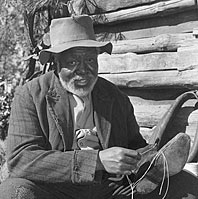- Home
- About The Movie
- Background
 Walt Disney on "The Appeal of the Theme"
Walt Disney on "The Appeal of the Theme"
Reprinted from Song of the South's 1946 Campaign Book:
"There is something endlessly appealing and satisfying in Joel Chandler Harris' droll fables of animals who behave like humans, and in the character who narrates them.
"For a long time they have been an open challenge to motion picture showmanship. I was familiar with the Uncle Remus tales since boyhood. From the time I began making animated features I have had them definitely in my production plans. But until now, the medium was not ready to give them an adequate film equivalent, in scope and fidelity.
"I always felt that Uncle Remus should be played by a living person, as should also the young boy to whom Harris' old negro philosopher relates his vivid stories of the Briar Patch. Several tests in previous pictures, especially in The Three Caballeros, were encouraging in the way living action and animation could be dovetailed. Finally, months ago, we 'took our foot in hand,' in the words of Uncle Remus, and jumped spang into our most venturesome but also more pleasurable undertaking.
"So, while we naturally had to compact the substance of many tales into those selected for our 'Song of the South,' in Technicolor, the task was not too difficult. And, I hope, nothing of the spirit of the earthy quality of the fables was lost.
"It is their timeless and living appeal; their magnificent pictoral quality; their rich and tolerant humor; their homely philosophy and cheerfulness, which made the Remus legends the top choice for our first production with flesh-and-blood players."
 Who Was Uncle Remus?
Who Was Uncle Remus?
Uncle Remus was a character created by a man named Joel Chandler Harris who initially began using this fictitious character in the Atlanta Constitution newspaper in 1876. The editor had asked him to carry on a column which had been featuring a black character, Uncle Si. Harris did not like the name or the way the column was handled, so he created his own. The stories Uncle Remus told were all based upon a composite of African-American storytellers he had known and grown up with as a child.
Two of these individuals, Bob Capers and Old Herbert, are largely credited as being the men who introduced Harris to these fantastic stories at a young age. As of recently, Bob Capers (also, Uncle Bob Capers) has been given the credit of being Harris' model for Remus. Allegedly, biographies and letters of Harris' indirectly deny that claim.
Another man, allegedly named Uncle Remus, who was a gardener in Forsyth, Georgia, was said to be the model for the Uncle Remus of Harris' books. According to a 1946 Song of the South press article, Harris also denied this in his private papers. In that same article, it states that Uncle Remus was probably not in fact based upon any one or two men, but at least a dozen different storytellers.
Whether any of the three men were direct models of Uncle Remus or a composite of a dozen storytellers or a combination of both, it remains clear that Uncle Remus is a combination of storytellers, and not necessarily just one man.
More in-depth information on Uncle Remus can be found on Wikipedia.
 Who Was Joel Chandler Harris?
Who Was Joel Chandler Harris?
Joel Chandler Harris was born in 1848 near Eatonton, Georgia. Harris first started writing when he was an apprentice typesetter on "The Countryman," the only weekly newsletter ever published on a plantation. It was here, on the Turnwold Plantation, that he became fascinated with the African legends of animal lore told by the slaves. Two men in particular, Bob Capers and Old Herbert, introduced him to the stories. Because of his close relationship with the slaves and their families on the plantation, Harris became well acquainted with their dialect and uniquely interpreted it into writing.
After the Civil War, Harris worked on various newspapers throughout the South. In 1870, he was offered an associate editorship on the Savannah Morning News.
It was in 1876 when the editor of the Atlanta Constitution asked him to take over a column called "Uncle Si" that Harris' Uncle Remus character first emerged. The column immediately began attracting widespread attention.
In 1880, Harris wrote his first book, "Uncle Remus: His Songs And Sayings" and was immediately acclaimed as one of the era's best writers, ranking with Mark Twain, Whitcomb Riley and George Washington Cable. He went on to write nine additional books and, in 1892, wrote a fictionalized life of his biography in "On The Plantation." The tales of Uncle Remus have been translated into 20 languages and immortalized on film by Walt Disney.
After 24 years with the Atlanta Constitution, Harris resigned to establish the Uncle Remus Magazine with his son Julian. In 1902, Harris' health began to fail, but he continued on until 1908 when he passed away.
"Humor is a great thing to live by, and other things being equal, it is a profitable thing to die by." – Joel Chandler Harris
More in-depth information on Joel Chandler Harris can be found on Wikipedia.
The Origins of Uncle Remus' Tales
Ethnologists have studied the origins of the Uncle Remus stories for quite some time. While it is for certain that most, if not all, of the tales were brought over to America from Africa during the slavetrading era, it has been speculated that some of the tales originate from India or even Egypt. Like all folklore, the stories changed slightly as they were handed down over the generations.
A footnote in Joel Chandler Harris' "Nights with Uncle Remus" asserts that ethnologists claim that all animal myths are a relic of zootheism, or animal worship. Harris believed without a doubt that some of Uncle Remus' actions, such as making cross marks in the sand and spitting in them, are the survival of some sort of obeisance in recognition of the presence of The Rabbit (Brer Rabbit), allegedly a great central figure and wonder-worker in African mythology.